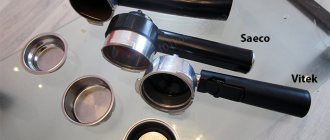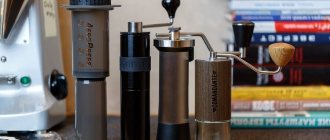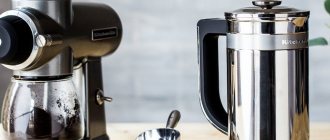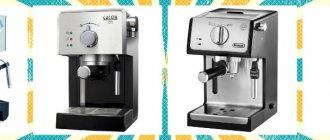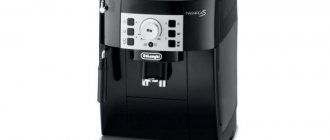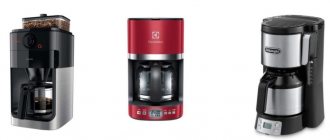Connoisseurs of natural coffee know: in order for the drink to fully reveal its taste and aroma, it must be prepared from freshly ground raw materials. This is due to the fact that the grains contain essential components. If you grind them and leave them for long-term storage, the aroma disappears and the taste of the drink deteriorates. Therefore, if you value natural ground coffee, you should consider purchasing a burr coffee grinder.
What is a burr coffee grinder?
Currently, there are 3 types of coffee grinders: manual or mechanical (in which one millstone is fixed and the other rotates manually), rotary (has an electrical control, and the grains are chopped with a sharp rotating knife) and electric (the grains inside are crushed by conical or flat millstones).
The millstone is available for sale in two versions: manual and electric . It resembles a miniature mill, rotating the handle with which you grind the grains.
The photo below shows some models of these devices:
Manual coffee grinders
Such devices can often be seen in souvenir shops and gift departments. Despite its “frivolity” in comparison with its industrial “relatives”, a manual coffee grinder has proven itself well.
It will take 15 to 20 minutes to get the fragrant powder that collects in the drawer. The grains are processed using the already known millstone method.
In a manual coffee grinder, the main thing is the strength of the handle and the quality of all components of the device. Given the degree and frequency of loading, they must withstand the pressure exerted on them.
In addition to the household coffee grinders described above, there are professional units for restaurants and bars.
If you decide to purchase a coffee grinder for yourself or as a gift, first study the information on the Internet using articles or reviews to get the necessary information before purchasing.
Advantages
The slow rotation of the tight handle, the barely audible creaking of the millstones, the air filled with a thick aroma - a manual coffee grinder can turn an ordinary process into meditation. But this is not the only thing that forces consumers to make their choice.
- Coffee beans are ground carefully, preserving their taste as much as possible.
- There is no danger of burning the grains during the process.
- You can adjust the degree of grinding.
- There is a container for ready-made coffee.
What types of coffee can be made using a burr grinder?
The ground coffee obtained from such a machine is suitable for preparing a wide variety of coffees. And for those that require a medium degree of grinding: espresso, cappuccino or mocha. And for those that cannot be prepared without very fine grinding, for example, oriental coffee. For coffee prepared in a French press, a coarse, coarse grind is quite suitable.
If you purchase a high-quality unit of this type, you will be able to prepare a wide variety of coffee at home! What size device is best to buy? Burr coffee grinders hold at least 200 grams in volume.
What should you know when choosing a burr coffee grinder?
Why? This is another fundamental difference between this model and it lies in the fact that such a machine can grind not the entire volume of the bowl, but only a part. Therefore, you can buy a coffee grinder of this size even for a small family and prepare coffee in small portions, as needed.
What power is right for you? Units of this type always have higher power than rotary units. In these models, the speed is significantly lower, and the grinding efficiency is increased by increasing the area of the disks (millstones). We evaluate the quality of the device
In a millstone-type device, a very significant point that requires special attention is the material from which the millstones are made. The best choice is ceramic discs, although they are more expensive.
Ceramic discs perfectly preserve the taste of coffee beans. Ideally, the wheels should be titanium coated; it makes the car extremely durable. The container for storing grains must be tightly closed.
After all, you want to preserve their aroma as much as possible! And the presence of a timer allows you to accurately measure the amount of coffee for a certain number of servings. Safety is a very important point!
Millstone configurations are, by definition, much safer than rotary ones. But in any case, you cannot let your guard down when using this machine. The first thing buyers pay attention to is the body. There are special requirements for its quality and strength.
Serious manufacturers use steel, aluminum or brass in their models. It is advisable that the machine has a locking function when the lid is removed or not fully closed. An important condition is the stability of the burr coffee grinder.
For a tighter fit to the surface, it should have rubber feet.
Principle of operation
The coffee grinder body is made of different materials: plastic, porcelain, brass, wood, steel .
The handle is attached to the side or top (on some European models, on the side of the wheel). The side one is easier to rotate. Some are made removable. Choose a device with rubberized legs - it will be more stable .
The burr coffee grinder has 2 containers : the consumer pours beans into one, and takes the powder from the second. Containers must be tightly closed to prevent the aroma from escaping.
For your information! Some models are equipped with an automatic shutdown function when the mechanism is clogged - it will help save the millstones from damage if a stone, stick or other small debris gets into them.
The engine overheating protection function is also useful . Some cases are equipped with a cord compartment, a cooling fan and a measuring spoon.
Comparison of manual and electric coffee grinders
Burr coffee grinders are divided into 2 groups: manual and electric.
In manual models, the millstones are driven by a handle, in electric ones - by a mains-powered motor.
Manual burr coffee grinders
Advantages:
- do not burn the ground powder;
- carefully grind the grains;
- better preserves the taste of coffee;
- have a longer service life;
- they are inexpensive.
The disadvantages are low productivity, low grinding speed and uneven grinding of grains. Electric millstone models perform a similar operation much faster.
Types of manual coffee grinders:
- The European cubic mill is a wooden box equipped with containers. Grinds a small amount of coffee at a time.
- The Turkish model is often metal, resembling a cylinder. When grinding, it is held in the hands.
- The modern coffee grinder is installed on a container into which the finished coffee will be poured, in the absence of its own similar container.
The grinding fineness is changed by adjusting the distance between the crushing parts by turning the screw on the handle or by moving the rotating shaft regulator. The handle is located on the top or side of the device. The bean container holds from 10 to 200 g.
The main advantage of a manual coffee grinder is that during grinding the coffee bean does not heat up, and the resulting powder retains all the properties and aroma of natural coffee.
Gourmets use hand-milled models as a tribute to the coffee-making ritual. These machines allow you to leisurely enjoy the process of grinding grains and the subsequent preparation of an aromatic drink. The budget cost of the device also plays an important role.
Electric burr grinders
Pros:
- grind coffee beans evenly from large fractions to powder;
- allow you to set the grinding fineness and regulate the dosage;
- have high productivity and grinding speed;
- grind overcooked hard grains;
- equipped with several operating modes, timer and protection.
Minuses:
- if there is no protection against overheating, at high grinding speeds the powder sometimes overheats;
- plane-parallel planes produce a lot of noise;
- the cost is much higher than that of manual models.
An electric burr coffee grinder for home allows you to serve a coffee drink to a large group in a short time.
Characteristics of electric models:
- adjustment of grinding degree (up to 15 modes);
- high power (100–300 W);
- large container volume for grains (up to 300 g);
- raw material dispenser;
- presence of a container for ground coffee;
- long service life.
On a note! An electric burr coffee grinder is suitable for those who love to discover new coffee flavors and often experiment with new types of coffee beans.
Materials for production
The material affects the taste of the drink, the uniformity of grinding and the life of the millstones. Each millstone has its own working resource. Ceramic ones need to be changed after 1000 kg of crushed grains, metal ones - after 500 kg .
- Hardened stainless steel
- Cast iron
- Ceramics
- Ceramic and corundum alloy
Cast iron is a durable, cheap and wear-resistant material .
However, it wears off over time, and the shavings that get into the coffee not only give it a metallic taste, but are also simply dangerous. Cast iron absorbs odors and transfers them to the powder (which will be noticeable if you first drank one type and then switched to another).
Steel is stronger, but wears out faster . In some models, the millstones are covered with a titanium film, which is easy to clean and does not attract odors. However, such a model will cost an order of magnitude more .
Ceramic millstones are similar in hardness to diamonds, but are the most fragile. They are not afraid of moisture, dampness and rust.
Corundum and ceramics are the most environmentally friendly and durable alloy . Gives the finest grind and resists abrasion.
Important! Buy new millstones only in specialized stores - only there you can buy high-quality parts. Make changes in time, otherwise the coffee will grind unevenly.
How to use the device?
In this video, you will be shown how to properly use a burr coffee grinder.
Experienced housewives, in addition to grinding coffee beans, find additional uses for this machine: grinding cereals, different types of dry pepper, seasonings, making powdered sugar from sugar. To grind these or other products, you should use household appliances designed specifically for this purpose - food processors or choppers.
The coffee grinder should only grind coffee! Study the warranty terms! If you have chosen an expensive model, you should inquire about the warranty period provided by the manufacturer. Millstones wear out over time, so it makes sense to consider future replacement.
With normal use (medium intensity), the millstones should last you at least one year, after which they need to be replaced at a specialized service center. However, in some models only the top millstone is removable. This means that the purchased device will not be able to serve you faithfully for a long time.
Market value of devices
Prices for professional coffee millstone grinders vary from 1,500 to 40,000 thousand rubles. Prices in Moscow and the regions do not have any fundamental difference. On average, the price range for this type of household appliances has developed at approximately the same level.
Types of millstones
There are 2 types of millstones : conical and plane-parallel.
Conical are a pair of cones, one of which is inside the second. The outer cone rotates, the one inside remains motionless. The grain falls between them and, grinding, slides down.
Such millstones work slowly, making it impossible to burn the grains , they make virtually no noise, but they also cost a fair amount.
Plane-parallel ones look like two washers touching each other. There are notches on the sides that are adjacent to each other. The advantage of these millstones is faster operation .
Attention! However, they make louder noise and exhaust their resources 2 times faster.
Adjusting the grinding degree
It is not possible to adjust the grinding degree once and for all; it is a constantly changing value . Both whole grains and powder are very sensitive to temperature and humidity, so the same raw material produces a slightly different taste product.
If the humidity is high, coffee particles will absorb moisture from the air and become bitter. The opposite effect will be observed if the air is too dry: the drink will sour.
The gap between the millstones is set manually, using a special ring built under the grain bowl. The greater the distance, the larger the particles will be.
Some machines have nuts that you loosen, turn as needed, and then tighten again.
About millstone flour and more
Is it true that millstone flour is the best and that it makes the most delicious and aromatic bread? This question has never ceased to occupy the best baking minds, and until now no one has found a definite answer. Perhaps this is precisely due to the fact that more often you can find roller-milled flour on sale rather than millstone flour. In the States, for example, millstone flour is highly valued; there the flour is considered “millstone” even if, after grinding in a millstone mill, it was subsequently ground by rollers or some other method. Jeffrey Hamelman says this with regret: “Today it is rare to taste bread made from truly millstone flour. I wonder if we could compare such bread with our usual bread made from roller-milled flour, would it be possible to give any of them a clear preference?”
Whole grain flour today is mainly produced in two ways: millstone and roller, in the first case, the grain is ground with stone millstones, while the flour particles are very small, like powder, the bran is relatively large, but not coarse, similar to thin flakes. This method of producing flour is thousands of years old; the first flour was obtained by grinding grain between stones, so it is believed that the millstone method of grinding is the most authentic. The roller method differs from the previous one: the grain is crushed with steel rollers, and not ground with millstones, and after the first grinding, more large particles are obtained than in millstone flour.
Here, for example, is an ancient millstone “mill” or even just a millstone. Probably, making flour using this unit is hard work.
And this is how a modern household burr mill works - this is the Hawos Easy .
To compare the product directly, I took wheat from one bag and ground part of it in a burr mill, and part in a crusher mill (yes, I’m a maniac, I have such a mill at home)), kneaded the dough according to the same recipe and baked bread.
But I note that my second mill is not a roller mill, it does not have rollers directly, but there are special metal blades that break the grain until the particles become the size of the cells of the sieve installed in the mill. It is with the help of a sieve that you can regulate the grinding in it: the finer the sieve, the smaller particles of grain it will let through and the finer the flour will be, and vice versa. But the result is flour similar to roller flour, which is sold in stores.
The difference in processing cannot but affect the result; flour from two different mills also turns out different. For clarity, here is millstone and crushed flour (millstone on the left, crushed on the right).
To take a closer look at the two types of flour, I took 50 grams of each. and sifted through a fine sieve to see how many large particles remained.
There are 8 grams of large particles left in the millstone.
And crushed - as much as 22!
Please note that in millstone flour the bran is larger than in crushed flour, but in general their amount is much less.
But what passed through the sieve is amazing white flour!
You can also determine the quality of flour grinding very simply by pouring a little flour on the back of your forearm, just above the hand, then grind it and blow. Thus, it is very easy to feel and even see which flour has more large particles and which has fewer: the more large particles left on your hand, the more of them there are in the flour.
How else do these two types of flour differ? In practice, this is reflected in the behavior of the dough during kneading, including moisture capacity. Non-millstone flour needs a longer resting time (autolysis) at the beginning of kneading, because due to the presence of a larger number of large particles, it absorbs water more easily than ground millstone flour. Therefore, kneading dough from roller flour requires a little more time than kneading dough from a millstone. Here, for example, is dough made from millstone flour (left) and flour from my second mill with metal blades at the end of kneading in the Ankarsrum Original dough mixer.
In addition, to obtain the same consistency of dough, millstone flour will require a little more water because it is more moisture-absorbing and absorbs more water than any other flour. I repeated the experiment that I described in this material and checked how much water both flours absorbed: I took 10 grams each. water, poured into flour and rolled into a ball as tight as possible. Then she weighed it, subtracted 10 (water) and got the amount of flour that the flour “attached” to itself.
The lump of millstone flour weighed 33.1 grams. (of which 23.1 is flour, and 10 is water), which means that the moisture content of millstone flour is almost 43.3%. The second lump of non-millstone flour weighed 34.4 grams. (24.4 flour), which means that the moisture capacity of flour is 40.9% (let me remind you that you can calculate the moisture capacity by dividing 1000 by the amount of flour that absorbed 10 grams of water). Thus, we were convinced in the park that millstone flour is more moisture-intensive.
Why does flour from the same grain, ground almost simultaneously, but in different mills, absorb different amounts of water? The secret lies in the degree of damage to the starch grains during the grinding process. As you know, starch also binds water, that is, it absorbs it, and the more starch molecules are damaged during the grinding process, the more water it is able to bind. However, this is only one side of the coin, the second touches on a topic that few home bakers (including myself) understand - biochemistry. But I’ll try to explain and not get confused myself: flour contains enzymes, which we have talked about more than once as “dough destroyers.” These are amylases (alpha and beta-amylases) that penetrate starch, saccharify it, that is, convert it into sugar, thereby preparing an ideal food for yeast. The yeast, in turn, eats the sugars into which the starch has turned and releases gas, which loosens the dough. Amylase “loves” destroyed starch grains more than whole ones, because it is much easier for it to penetrate into destroyed ones; accordingly, the more and more starch is destroyed in the dough, the more actively amylase “works.”
On the one hand, this feature speeds up fermentation, which is to our advantage, but on the other hand, it leads to the rapid destruction of the dough. As we said above, the more damaged starch grains in the flour, the more moisture the dough can absorb. During kneading with such flour, it seems that even more water needs to be added, and many (especially me) do, but as fermentation proceeds, this excess water begins to gradually be released, making the structure of the dough weaker. How this is expressed in practice:
— the dough made from such flour becomes sticky and sluggish by the end of kneading, it is easy to knead;
— blanks made from such flour can “float” during proofing or during rounding;
— at the end of fermentation, the workpieces become sticky;
— the incisions do not open enough or do not open at all.
Such “tricks” can be thrown out by whole grain dough made from flour with a large percentage of destroyed starch (more than 10%). All these features of the dough are well known to me; every time I work with whole grain dough, I come across them to one degree or another, but I won’t say that my flour contains a large percentage of destroyed starch, I just don’t know.
I decided to experiment and bake whole grain wheat bread using millstone flour and flour from a second mill. In fact, I have baked both many times before, but never paid so much attention to the characteristics of the dough in the context of grinding flour. I showed what both flours look like above, so I’ll start right away with autolysis.
Here is a dough made from non-millstone flour, which was just mixed with water, it immediately showed that it contains gluten, but at the same time the grainy structure is clearly visible.
And here is the millstone dough at the very beginning of autolysis. Similar to the first one, but feels smoother.
And here is the finished dough. The first is not made from millstone flour, it is more coarse, and the second is smoother, which is easy to notice with the naked eye.
At the height of fermentation, the structure of the dough is also different; dough made from crushed flour seems more porous (left).
But the finished bread surprised me a little. Bread made from crushed flour turned out less fluffy, but with more open pores.
But the millstone turned out to be much more magnificent, it opened up perfectly along the cuts, but at the same time with a denser pattern of pores.
Although you are unlikely to determine which bread is which by the appearance of the pieces.
As for the taste, I give up here, both breads are tasty, with a pleasant sweet aftertaste characteristic of whole grain wheat bread, and a pleasant soft aroma.
To be fair, I note that millstone flour is also valued in our country and is more preferred to roller flour, but more often you can find roller flour on sale. Millstone flour is more expensive to produce: burr mills are produced by only a few manufacturing companies around the world and they can be counted on one hand (there will still be extra fingers left), these mills are more expensive, consume more energy, while producing less flour than roller mills. But at the same time, it is the burr mill that can produce the highest quality finely ground flour with delicate bran, which crunches so deliciously in the bread crust; no other mill is capable of this.
burr mills in the store hlebomoli.ru
And here's some more delicious bread and baking in a ceramic set from Emile Henry.
Have some delicious bread, see you soon!
about flour, article
Elena Zheleznyak
Author
What does engine power affect?
The power of modern engines in coffee grinders varies from 100 to 600 W. This indicator affects the quality of grinding, speed and overall performance of the device, however, it should not be decisive when purchasing.
For home use, 100-200 W will be enough for you (180-270 W if you like heavily roasted crushed coffee beans). Higher indicators will be needed when choosing a device for a coffee shop, etc.
Criteria for choosing burr type coffee grinders
When choosing a burr coffee grinder, it is important to consider several factors.
Millstone type
Millstones are conical and plane-parallel.
The type affects the service life. Conical ones consist of two cones inserted into one another - an external (stationary) and an internal (rotating) one. Conical millstones operate almost silently and with less overheating, they are more durable and last longer.
Plane-parallel ones consist of 2 disc-washers, the edges of which are connected by notches. The grains are ground as they fall between the millstones. The operating speed of discs is higher than that of cones, the background noise is greater and wear occurs faster - frequent replacement of washers is required.
Millstone material
Not only the service life of the coffee grinder, but also the taste of the coffee produced depends on the material:
- Stainless steel is strong, wear-resistant, durable, but susceptible to moisture.
- Cast iron is inexpensive and durable, but over time it imparts a metallic taste to the ground coffee. Used in hand-held devices.
- Titanium-coated steel is used in professional devices. She is impeccable in her work.
- The alloy of ceramics with corundum ensures a long service life and uniform grinding, is not afraid of moisture and does not absorb foreign odors.
Important! Metal cones are designed to process 250–500 kg of grains, ceramic alloy - 1000 kg. The optimal material is considered to be a ceramic alloy with corundum, although it is expensive.
Adjusting the grinding degree
There are many ways to brew coffee, and each requires a different grind size. For Turks, grind the finest into dust so that the aroma can be revealed as much as possible and the coffee is thick. French press, drip and geyser coffee makers prefer medium grinding, and not necessarily uniform.
For carob coffee makers, the uniformity of the ground coffee is important, otherwise it will not be possible to properly compress the coffee in the holder, and the brewing will be partial.
When choosing, it is important to know:
- a ring or slider will help control the degree of grinding of grains;
- the desired particle size is achieved by changing the distance between the millstones;
- The number of grinding levels depends on the coffee grinder model.
Cleaning the machine
Daily grinding of grains requires cleaning the machine at least once a month.
Removable containers make the task much easier.
To clean the millstones, you need to unscrew the screws and their fastenings and clean the mechanism with a special brush.
Washing is not recommended due to the risk of rust.
Containers for grains and finished powder
Made from glass, metal and plastic. Glass containers are preferable: they do not collect static electricity, are easier to clean and do not absorb odors. The only downside is that they break easily.
Engine power
The range of indicators is from 100 to 600 W. Affects the productivity and ability to process particularly hard coffee beans. The preferred power is from 100 to 170 W. For heavily overcooked grains, a device with a power of 150–180 W is more suitable.
Additional functions
The use of a coffee grinder is greatly facilitated by additional functions:
- a timer (electronic, second, mechanical) counts the amount of ground powder and the time to grind one portion;
- automatic shutdown when clogged helps prevent the millstones from being destroyed when a stone or other solid foreign body hits them;
- a cooling fan saves coffee powder from overheating during grinding;
- Rubberized feet prevent the device from moving due to vibration during grinding.
Step-by-step instructions for use
- The first thing to do is check the cleanliness of the containers . Containers should not have any foreign odors and be dry.
- Pour the required amount of grains (a portion or a whole pack) into the bowl and either turn on the device or start turning the handle. You shouldn’t grind coffee “in reserve” : in a container, even the most airtight, the powder will quickly lose all the subtlety of its aroma.
- Pour the coffee into a cup and brew.
- Wipe containers thoroughly to remove any remaining powder . Let them air out a bit.
You can grind coffee into a fine powder in rotary coffee grinders in 15-20 seconds; for medium grinding it will take 13 seconds, for coarse grinding – 10 seconds.
If your drink has a tasteless sourness, increase the size of the coffee granules . Reducing the grinding speed will help remove excess bitterness.
Care
There is nothing difficult about caring for a burr coffee grinder. Moreover, there are no significant differences - whether they are electric or manual. But you need to do this regularly!
- Unplug the electric coffee grinder, but not just by pressing the button, but by unplugging the cord from the outlet .
- Using a dry cloth or damp (not wet) rag, clean the internal walls and parts from any remaining ground grains . If you do not do this after each grinding, over time both the walls and parts will become covered with an oil coating. You can use a soft thin brush or brush to clean the smoking pipe, or a cotton swab - they will help remove coffee residues from hard-to-reach places.
- In some models, the grinding mechanism can be pulled out completely, but do not do this without first understanding the instructions. Rinse the parts in warm water and dry. You cannot use dishwashing detergents - the smell will be difficult to remove .
A coffee grinder is designed for grinding coffee, and if you try to process cereals or sugar in it, you risk severely damaging the unit .
Microparticles of powdered sugar, once caught in the mechanical “filling” of the coffee grinder, stick together and can cause serious operational problems.
Rice is completely harder than grains and the starch contained in it. In addition, a foreign odor will be mixed with the aroma of coffee.
Why do you need a coffee grinder?
I also want to answer the question: “Why do I need a coffee grinder if you can buy ground coffee in the store?” It's a fair question, isn't it?
So, the answer lies in time! From the time manufacturers grind the coffee beans to the time they package them, a sufficient amount of time passes during which some of the coffee's aroma and taste evaporate.
Even if the ground coffee is quickly packed in a vacuum package, as soon as you open it, you will no longer be able to retain the “freshness” of the coffee. It is worth noting that even if you are going to store ground coffee in an airtight container, reactive oxygen from the air will neutralize the unique aroma of coffee irrevocably.
It’s another matter when a couple of minutes pass from the moment of grinding to the moment of brewing. It is because of this that coffee grinders are quite popular among people around the world.
Some coffee makers and almost all coffee machines have a coffee grinder function.
Manual or electric model - which is better?
Not so long ago there was only one type of coffee grinder. Nowadays, there are so many of them that you inevitably fall into a stupor, trying to choose a suitable copy. Each type has its own advantages, but there are also disadvantages.
Note! In manual coffee grinders, the grain is poured into a special container, the handle is turned and the powder necessary for preparing the drink is obtained.
And, despite the variety of electric models, many coffee connoisseurs have old manual models in their kitchen . It's quite understandable why.
- The manual coffee grinder is easy to wash and dry .
- Its compact dimensions allow you to place the device anywhere : on any size table, stool and even window sill.
- It is universal and can be used in any conditions . It doesn't need current or batteries.
- Coffee beans are ground evenly without burning, preserving the aroma and taste.
- Manual coffee grinders are sold at a very affordable price: from 1100 rubles . Oriental (cylindrical) models are slightly more expensive than traditional European ones, as are those with stone or ceramic millstones.
- There is a slight noise during operation, but it cannot be compared with the noise from an electrical device.
- Serves faithfully for many years.
the downsides .
- It is not always possible to find time for grinding. To prepare one shot of espresso you will need to spin the millstones for some time .
- Human energy is wasted.
- The container into which the grains are poured is usually small.
- To adjust the degree of grinding in European-type coffee grinders, you need to remove the fastening screw, washer, pull out the handle, and only then will you be able to get to the adjusting nut.
The electric coffee grinder was invented primarily to save human effort and time . It will be convenient for a spacious kitchen, for a large family.
- In order to grind a portion of coffee, you just need to press one button , and not persistently turn the handle.
- In most electric coffee grinders, the bean reservoirs are designed to hold a large portion - a whole pack. Accordingly, in one procedure you will receive a large amount of powder .
Flaws:
- Electric coffee grinders are larger than regular grinders and cannot operate without electricity . You have to place it closer to the outlet, which is not always convenient in a small kitchen or with a large number of electrical appliances.
- Often the grinding quality is low (this depends on the type of machine: a knife grinder does not produce uniform grinding, it is better to choose an electric millstone).
- There is a high risk of burning the grain if you grind coffee for a long time and in large quantities.
- There are no silent electric coffee grinders , alas. And no matter how hard manufacturers try, the stronger the motor, the more noise it makes.
- The cost is great . Of course, there are devices on sale for 1000-2000 rubles, but reviews of these are not the most rosy, and high-quality ones cost from 5000 rubles and above.
Advantages and disadvantages
Both electric and manual coffee grinders with conical burrs have many advantages compared to other types of units:
- only millstones can provide high-quality grinding;
- multifunctionality of devices makes life easier;
- it is possible to obtain raw materials for various coffee drinks;
- reasonable cost;
- opportunity to save effort and time.
There are only a few disadvantages:
- breakdowns are possible when foreign objects get into the millstones;
- Sometimes difficulties arise in obtaining the finest fractions.
